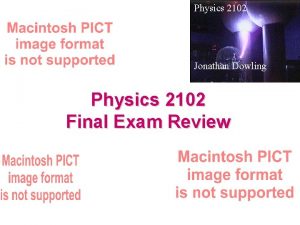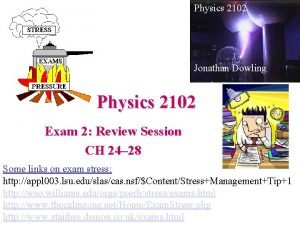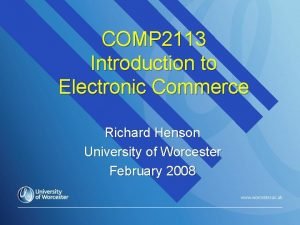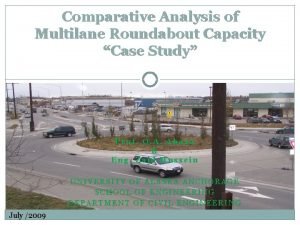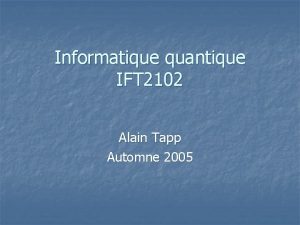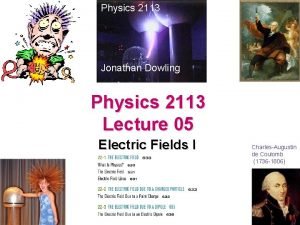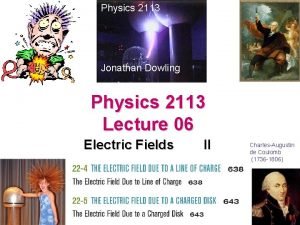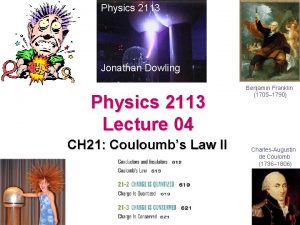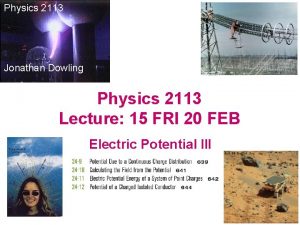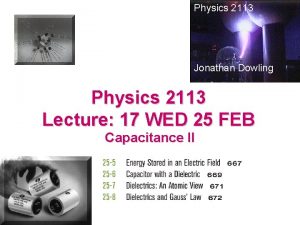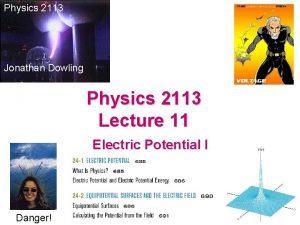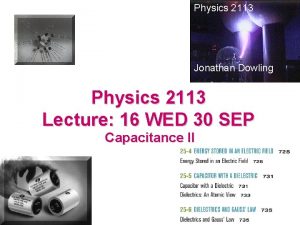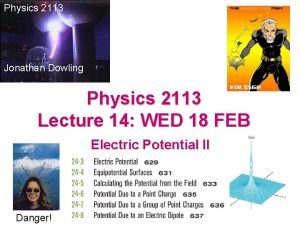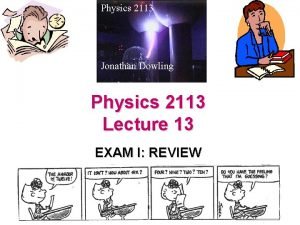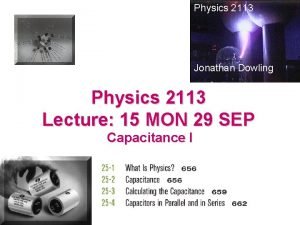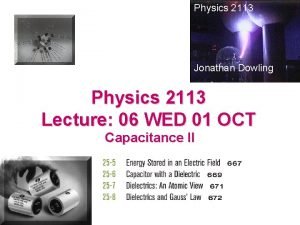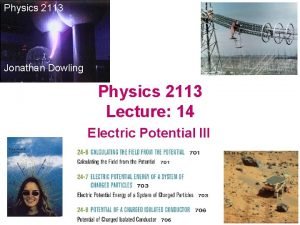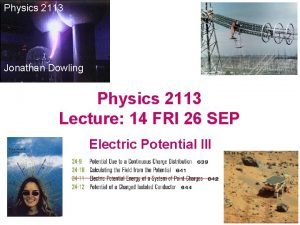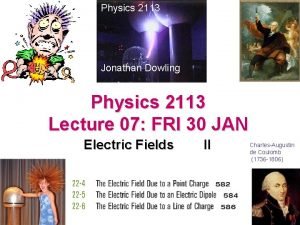Physics 2113 Jonathan Dowling Physics 2102 Lecture 12

![Volume [m 3] Area [m 2] Circumference [m] Sphere Circle Cylinder Volume [m 3] Area [m 2] Circumference [m] Sphere Circle Cylinder](https://slidetodoc.com/presentation_image/00beea6fc8e4489fd7737c127da6bec6/image-2.jpg)


![Electric Potential Energy, Electric Potential Units : Potential Energy = U = [J] = Electric Potential Energy, Electric Potential Units : Potential Energy = U = [J] =](https://slidetodoc.com/presentation_image/00beea6fc8e4489fd7737c127da6bec6/image-5.jpg)










- Slides: 15

Physics 2113 Jonathan Dowling Physics 2102 Lecture 12: WED 22 SEP Electric Potential I Danger!
![Volume m 3 Area m 2 Circumference m Sphere Circle Cylinder Volume [m 3] Area [m 2] Circumference [m] Sphere Circle Cylinder](https://slidetodoc.com/presentation_image/00beea6fc8e4489fd7737c127da6bec6/image-2.jpg)
Volume [m 3] Area [m 2] Circumference [m] Sphere Circle Cylinder

Electric Potential Energy U is Negative of the Work W to Bring Charges in From Infinity: U = –W∞ The Change in Potential Energy ΔU Between an Initial and Final Configuration Is Negative the Work W Done by the Electrostatic Forces: ΔU = Uf – Ui = –W +Q • What is the potential energy of a single –Q +Q a charge? • What is the potential energy of a dipole? • A proton moves from point i to point f in a uniform electric field, as shown. - Does the electric field do positive or negative work on the proton? - Does the electric potential energy of the proton increase or decrease?

Electric Potential Electric potential difference between two points = work per unit charge needed to move a charge between the two points: ΔV = Vf – Vi = –W/q = ΔU/q
![Electric Potential Energy Electric Potential Units Potential Energy U J Electric Potential Energy, Electric Potential Units : Potential Energy = U = [J] =](https://slidetodoc.com/presentation_image/00beea6fc8e4489fd7737c127da6bec6/image-5.jpg)
Electric Potential Energy, Electric Potential Units : Potential Energy = U = [J] = Joules Electric Potential = V = U/q = [J/C] = [Nm/C] = [V] = Volts Electric Field = E = [N/C] = [V/m] = Volts per meter Electron Volt = 1 e. V = Work Needed to Move an Electron Through a Potential Difference of 1 V: W = qΔV = e x 1 V = 1. 60 10– 19 C x 1 J/C = 1. 60 10– 19 J

Electric Potential and Electric Potential Energy The change in potential energy of a charge q moving from point i to point f is equal to the work done by the applied force, which is equal to minus the work done by the electric field, which is related to the difference in electric potential: We move a proton from point i to point f in a uniform electric field, as shown. • Does the electric field do positive or negative work on the proton? • Does the electric potential energy of the proton increase or decrease? • Does our force do positive or negative work ? • Does the proton move to a higher or lower potential?

Positive Work +Q a +Q Negative Work +Q a –Q

Positive Work Charge Moves Uphill +Q a +Q Negative Work +Q a –Q Charge Moves Downhill


ICPP: Consider a positive and a negative charge, freely moving in a uniform electric field. True or false? (a) Positive charge moves to points with lower potential. (b) Negative charge moves to points with lower potential. (c) Positive charge moves to a lower potential energy. (d) Negative charge moves to a lower potential energy. (a) True (b) False (c) True (d) True +++++ –Q –––– +Q +V 0 –V


electron ✔ ✔ ✔

Summary: • Electric potential: work needed to bring +1 C from infinity; units V = Volt • Electric potential uniquely defined for every point in space -independent of path! • Electric potential is a scalar — add contributions from individual point charges • We calculated the electric potential produced by a single charge: V=kq/r, and by continuous charge distributions: d. V=kdq/r • Electric potential energy: work used to build the system, charge by charge. Use W=q. V for each charge.


Midterm Exam #1 • • Dowling Section No. 2: AVG = 73; STDV=12 Pullin Section No. 3: Avg. = 70 A: 90 -100% B: 75 -89% C: 60 -74% D: 50 -59% F: 49 -0%
 Jonathan dowling
Jonathan dowling Jonathan dowling
Jonathan dowling Art.2113 cc
Art.2113 cc Afi 36 2113
Afi 36 2113 Comp 2113
Comp 2113 International human resource management dowling 6th edition
International human resource management dowling 6th edition Shock mnemonic
Shock mnemonic Dowling optical
Dowling optical Dowling roundabout
Dowling roundabout Ift-2102
Ift-2102 Nutrition 2102
Nutrition 2102 Nutrition 2102
Nutrition 2102 Nutrition 3102
Nutrition 3102 Sos.texas.gov form 2102
Sos.texas.gov form 2102 01:640:244 lecture notes - lecture 15: plat, idah, farad
01:640:244 lecture notes - lecture 15: plat, idah, farad Physics 101 lecture notes pdf
Physics 101 lecture notes pdf
